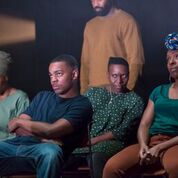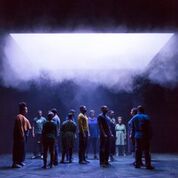
Dorothy Chansky
|
Review of "Ear for Eye" "Ear for Eye"
Debbie Tucker Green is a poet adept at thinking simultaneously in words and embodiment. "Ear for Eye," Green's new work at London's Royal Court Theatre, shares some aesthetic DNA with the late Ntozake Shange's "for colored girls who have considered suicide/when the rainbow is enuf." But four-plus decades separate these two indices of the black side of the racial divide in the United States (and, in this work, to a smaller extent in Britain). On Green's stage, the gloves are off. If I've parsed the title correctly, "Ear for Eye" is saying "listen up," because living with a belief in a visual color line is only going to yield more violence. And after 130 minutes with Green's words, there should be no question about the justified rage conveyed by the most articulate of her characters. So, any "eye for an eye" reading is also kind of a good reading.
Did I say "good?" Little in the world Green brings to life is good, although every one of her sixteen performers is that and then some. Two sets of parents—one in the U.S. and one in the U.K.—have a version of "the talk" with their sons. (The parents are played by Sarah Quist, Anita Reynolds, George Eggay, and Faz Singhateh.) In both cases, there are endless warnings about gesture and body language. Anything from a shrug to looking a white man in the eye can be dangerous to the health and well-being of a young black male. That one of the sons is hearing-impaired and depends on his body and hands to speak is beyond ironic. (The sons are played by Jamal Ajala and Hayden McLean.) It is one of the many rock-and-a-hard place set-ups that Green condenses into lyricism—some instances insouciant, all infuriating. The second (of three) parts of the evening is an extended scene between a white male psychologist and a black female social worker. No one will be surprised that he interrupts her, twists her words, and treats her like an ignorant amateur. The slowly revolving turntable on which the extended encounter—really a series of encounters—is staged suggests a sparring arena. Wholly unlike the first part of the show, this one resembles a traditional play, even thought its characters are not given names and its exact setting (a school? a court?) is never identified. The two experts' positions vis-à-vis youth who kill with guns are inflected by the elephant in the room: race. Can murder be excused? No. Can the lives leading up to the heinous acts be variously unpacked, examined, and maybe partially understood? Obviously, yes.
Only when the social worker reaches the point of letting the psychologist know that he seems to have racist intolerance towards her—never mind the boys—does he ramp up from condescending and dismissive to insulting and hostile. It's hard to see any semblance of a fair match here, as he is scripted by Green to be a jerk (and actor Demetri Goritsas obliges with a performance that raised hoots of derision in the audience). But there is no way it could be a fair fight even if he had better manners. Lashana Lynch as the social worker plays a subtle but honest hand, slowly unravelling as it becomes clear that the game is rigged. There are shades of David Mamet's "Oleanna" here (male professor underestimates female student, who destroys his career), but Green places more at stake than professional privilege or an individual career. The third, and shortest, section is a litany of segregationist laws enacted in the United States, recited by white performers ranging from children to septuagenarians. (They seem like non-professional actors simply asked to read.) Presenting these speakers as projected videos provides a weird kind of intimacy but also lends a scary officialdom to the section. These were encoded laws. This video will exist long after the live actors have gone on to their next gigs when this show closes.
Green's unabashed goals are to arouse (out)rage and to insist that the time is now. While "Ear for Eye" struck me as longer than it might have needed to be, I suspect the response to such a suggestion would be that the fury it conveys has been fueled longer than any sense of civility should tolerate. "Too long" indeed. |
| museums | NYTW mail | recordings | coupons | publications | classified |




